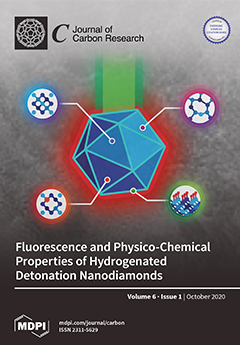High-surface-area carbons are of interest as potential candidates to store H
2 for fuel–cell power applications. Earlier work has been ambiguous and inconclusive on the effect of boron doping on H
2 binding energy. Here, we describe a systematic dispersion–corrected density functional theory
[...] Read more.
High-surface-area carbons are of interest as potential candidates to store H
2 for fuel–cell power applications. Earlier work has been ambiguous and inconclusive on the effect of boron doping on H
2 binding energy. Here, we describe a systematic dispersion–corrected density functional theory study to evaluate the effect of boron doping. We observe some enhancement in H
2 binding, due to the presence of a defect, such as terminal hydrogen or distortion from planarity, introduced by the inclusion of boron into a graphene ring, which creates hydrogen adsorption sites with slightly increased binding energy. The increase is from −5 kJ/mol H
2 for the pure carbon matrix to −7 kJ/mol H
2 for the boron–doped system with the boron content of ~7%. The H
2 binding sites have little direct interaction with boron. However, the largest enhancement in physi-sorption energy is seen for systems, where H
2 is confined between layers at a distance of about 7 Å, where the H
2 binding nearly doubles to −11 kJ/mol H
2. These findings suggest that interplanar nanoconfinement might be more effective in enhancing H
2 binding. Smaller coronene model is shown to be beneficial for understanding the dependence of interaction energy on the structural configurations and preferential H
2 binding sites.
Full article





